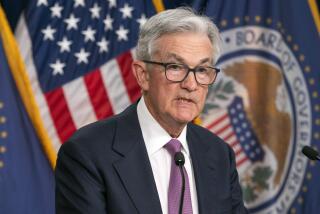Bernanke says Federal Reserve will scale back stimulus policies . . . eventually
- Share via
Reporting from Washington — A snowstorm Wednesday didn’t keep Federal Reserve Chairman Ben S. Bernanke from outlining to lawmakers how the central bank might pull back its unprecedented intervention in the U.S. economy. But how exactly the long-awaited exit strategy would be deployed was obscured in a blizzard of ambiguities.
“Although at present the U.S. economy continues to require the support of highly accommodative monetary policies, at some point the Federal Reserve will need to tighten financial conditions by raising short-term interest rates and reducing the quantity of bank reserves outstanding,” Bernanke wrote in prepared testimony for a hearing Wednesday by the House Financial Services Committee.
The hearing to address the Fed’s exit strategy was postponed because of a major snowstorm in Washington, but the Fed released Bernanke’s testimony anyway. He provided new details of how the Fed might scale back the steps it had taken to keep credit flowing in the wake of the financial crisis without pushing the economy back into recession.
But although Bernanke talked a lot about what the Fed could do, he said little about when it might do it, sprinkling his remarks with vague terms, such as “in due course” and “at some point.”
“We have spent considerable effort in developing the tools we will need to remove policy accommodation, and we are fully confident that at the appropriate time we will be able to do so effectively,” he said.
Bernanke said one area the Fed was focusing on was the money banks were holding as reserves. At the height of the crisis in the fall of 2008, Congress gave the central bank the authority to pay interest on such funds as a way of stabilizing the banking system. By increasing the interest rate on those reserves, the Fed would push up all short-term interest rates from their historic lows.
Although that could increase borrowing costs to consumers and businesses, it would allow the Fed to tighten the money supply to prevent inflation as the economy recovers.
The Fed also is intent on reducing the reserves held by banks, which would free up more money for lending. The Fed is looking at expanding so-called reverse repurchase agreements, which allow banks to drain some of their reserves, and allowing banks to convert reserves into something “roughly analogous to certificates of deposit” that could be used to meet short-term liquidity needs, Bernanke says.
But Bernanke was vague on when it might use those tools, and in what order, suggesting the Fed might start slowly. Lawmakers likely will press him for details when the hearing takes place.
“The sequencing of steps and the combination of tools that the Federal Reserve uses as it exits from its currently very accommodative policy stance will depend on economic and financial developments,” Bernanke said. “One possible sequence would involve the Federal Reserve continuing to test its tools for draining reserves on a limited basis, in order to further ensure preparedness and to give market participants a period of time to become familiar with their operation. As the time for the removal of policy accommodation draws near, those operations could be scaled up to drain more significant volumes of reserve balances to provide tighter control over short-term interest rates.”
Bernanke reiterated that the central bank was likely to keep the interest rate historically low for “an extended period.” But he said he was confident the Fed would be able to reduce the size of its balance sheet, which ballooned to $2.2 trillion as it took on riskier investments than the Treasury securities normally purchased.
“In the long run, the Federal Reserve anticipates that its balance sheet will shrink toward more historically normal levels and that most or all of its security holdings will be Treasury securities,” Bernanke said. He also predicted that the expanded Fed programs, including large-scale purchases of mortgage-backed securities from Fannie Mae and Freddie Mac, “are likely to generate significant positive returns for taxpayers.”
More to Read
Inside the business of entertainment
The Wide Shot brings you news, analysis and insights on everything from streaming wars to production — and what it all means for the future.
You may occasionally receive promotional content from the Los Angeles Times.











